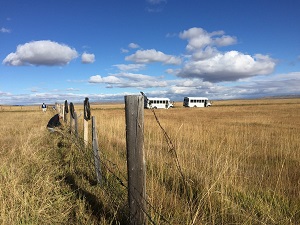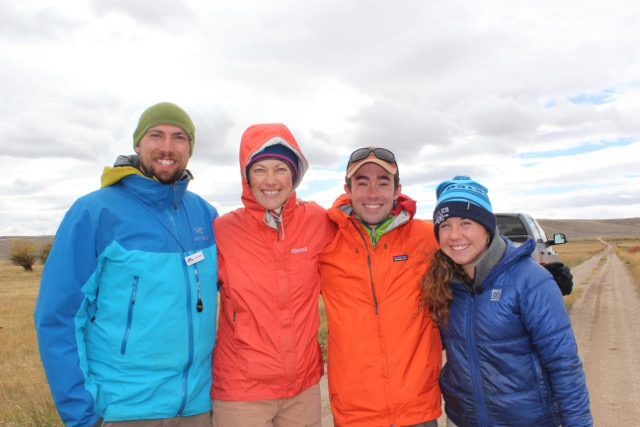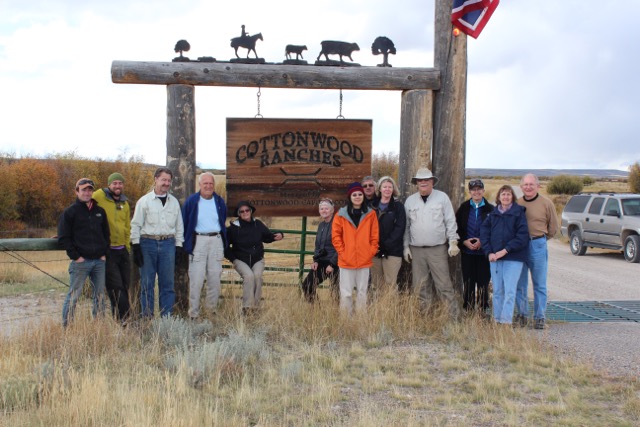
We arrive at Cottonwood Ranch on a chilly, overcast October morning. We are met by owner Freddie Botur, who takes us into his ranch office. Tall and lean, Freddie is every bit the proverbial American cowboy. He is dressed in muddied work boots, blue jeans, and a full-brimmed hat and bandana. His office, on the other hand, looks like part rancher man-cave and part office for a tenure track biology professor. There’s a couch, small kitchen, some tools strewn about, but the walls are what catch my eye. They are covered with posters showing LIDAR satellite images of the ranch’s riparian habitat along Cottonwood Creek. Freddie points to the before and after pictures of native willow coverage, some of which has greatly expanded under his targeted grazing restrictions.
 He explains to us that our goal over the next two days will be to improve the quality of his land by removing barbed wire fencing. While effective for corralling livestock, traditional barbed wire comes with unintentional consequences for native wildlife. A low-hanging wire can snare pronghorn antelope, which generally travel beneath fences, and the upper wires can entangle deer, moose, and other animals that attempt to jump the fences.
He explains to us that our goal over the next two days will be to improve the quality of his land by removing barbed wire fencing. While effective for corralling livestock, traditional barbed wire comes with unintentional consequences for native wildlife. A low-hanging wire can snare pronghorn antelope, which generally travel beneath fences, and the upper wires can entangle deer, moose, and other animals that attempt to jump the fences.
Each fall for nearly a decade, the Magnificent Moose Road Scholar Program offered by Teton Science Schools has traveled to Cottonwood Ranch to work with Freddie and his ranch hands to improve wildlife habitat. Freddie’s property covers 75,000 acres of classic Wyoming open range. The property stretches westward from the town of Daniel, in the Green River Basin, all the way to the foothills the Wyoming Range. On a clear day, from the ancient river terraces above Cottonwood Creek, you can see the granite peaks of the Wind Rivers, rising from the sagebrush steppe thirty miles to the east.
Cottonwood Ranch is a working cattle ranch. Freddie’s land is an open range patchwork of old pioneer homesteads, a property that has been in the Botur family for almost forty years. Freddie grazes cattle here during the fair weather months and ships his herd south to Colorado for the wintertime. In recent years, Freddie has made increased efforts to balance what is good for his cattle with what is good for the native wildlife. His herd shares sagebrush and willow flats with moose, deer, elk, and pronghorn. In fact, statewide migration corridors, super-highways for large ungulates, intersect the property. The mule deer and pronghorn that travel annually through this part of the Green River Basin claim the two longest land animal migrations in the lower forty-eight.
 Although Cottonwood Ranch is private land, and despite the fact that environmentally friendly innovations come with a cost, Freddie is dedicated to replacing miles of barbed wire fencing with top-rail wildlife friendly fencing and has initiated rotational grazing practices that keep cattle away from sensitive habitat. This has resulted in healthier grazing land, and, as willow coverage expands along Cottonwood Creek, a more stable water table in the critical riparian zone. Working with the Wyoming Stock Growers Agricultural Land Trust and the Conservation Fund, Freddie has also been able to place conservation easements on parts of his property. Cottonwood Ranch’s strong environmental ethos is the reason we are here to help.
Although Cottonwood Ranch is private land, and despite the fact that environmentally friendly innovations come with a cost, Freddie is dedicated to replacing miles of barbed wire fencing with top-rail wildlife friendly fencing and has initiated rotational grazing practices that keep cattle away from sensitive habitat. This has resulted in healthier grazing land, and, as willow coverage expands along Cottonwood Creek, a more stable water table in the critical riparian zone. Working with the Wyoming Stock Growers Agricultural Land Trust and the Conservation Fund, Freddie has also been able to place conservation easements on parts of his property. Cottonwood Ranch’s strong environmental ethos is the reason we are here to help.
Road Scholar, formerly known as Elderhostel, is a non-profit that offers experiential learning adventures for lifelong learners. The annual visit to Cottonwood Ranch is part of a week-long program at Teton Science Schools focused on stewardship projects in the Greater Yellowstone Ecosystem. This year, in addition to Cottonwood Ranch, the Magnificent Moose also spent time working on a trail for Teton Science Schools and on a project with the National Park Service in Grand Teton National Park.
Jacob and Donna, a couple from Pennsylvania, have returned year after year to be part of these projects. “Each year is totally different than the year before, and you learn something new each year,” says Donna. “This program is unique in that people come out to this part of the world to work really hard,” says Jacob. “Most of the time when people come to Grand Teton and its surrounding mountain ranges, it’s for vacation, to see things, to go for a hike. This group, on the other hand, gets great satisfaction out of seeing the effects of the work that they’ve done. Seeing the progress they’ve made over the years is incredible.”
 Unlike many of our participants, this is my first year on the ranch, and the barbed wire removal process is new for me. At first, progress is slow. I learn by leaning on the advice of the returners. We find that the best way to remove barbed wire is to work in two person teams. One teammate cuts the wire and pulls staples from the fence post, while the other follows behind coiling the freed wire strand. Fence posts are tediously removed with a jack and a chain, and holes are filled in with dirt and a shovel. It’s physically demanding work (this is why cowboys don’t need gym memberships), but it’s rewarding. We can see our progress laid out behind us with every wire and post we remove.
Unlike many of our participants, this is my first year on the ranch, and the barbed wire removal process is new for me. At first, progress is slow. I learn by leaning on the advice of the returners. We find that the best way to remove barbed wire is to work in two person teams. One teammate cuts the wire and pulls staples from the fence post, while the other follows behind coiling the freed wire strand. Fence posts are tediously removed with a jack and a chain, and holes are filled in with dirt and a shovel. It’s physically demanding work (this is why cowboys don’t need gym memberships), but it’s rewarding. We can see our progress laid out behind us with every wire and post we remove.
I ask Wayne, a veteran of the program from Kansas, why he keeps coming back: “The friendships you make, to get to see everyone year after year. You keep coming back to see them and get along year after year. Plus you get to go to the ranch, that’s the highlight.”
Midway through our first morning the weather improves and working conditions are ideal. Snow clouds veil the tops of the mountain ranges in the distance, but the sky in the basin is sunny and clear. As if on cue, three moose, a cow, calf and bull, begin to weave in and out of a nearby patch of willows. We watch them from a safe distance as we pull wire. Framed against the backdrop of yellow and orange bushes only a week or so past their peak fall colors, the moose triad is a timely reminder of why we are here.
 Freddie’s forward-thinking style of ranch management has not gone unnoticed. He was recently featured in an environmental documentary, and students from the University of Wyoming routinely conduct biological research on the ranch. Eventually, Freddie hopes to replace his cows with the land’s native grazing species, the American bison. Freddie tells us that at first, other ranchers in the area were skeptical of his innovations. It wasn’t until he proved he could run the ranch his way without running it into the ground financially that people started paying attention. This seems often to be the case; like removing fencing, positive change can be frustratingly gradual. Ideas progress in small increments. One strand of barbed wire at a time, then one ranch at a time, basin to basin, city to city, until the idea gains a foothold and the current paradigm is challenged.
Freddie’s forward-thinking style of ranch management has not gone unnoticed. He was recently featured in an environmental documentary, and students from the University of Wyoming routinely conduct biological research on the ranch. Eventually, Freddie hopes to replace his cows with the land’s native grazing species, the American bison. Freddie tells us that at first, other ranchers in the area were skeptical of his innovations. It wasn’t until he proved he could run the ranch his way without running it into the ground financially that people started paying attention. This seems often to be the case; like removing fencing, positive change can be frustratingly gradual. Ideas progress in small increments. One strand of barbed wire at a time, then one ranch at a time, basin to basin, city to city, until the idea gains a foothold and the current paradigm is challenged.
By the end of the two days we remove almost a full mile of barbed wire. This is both an amazing effort and tiny fraction of the job that remains to be completed on Cottonwood Ranch. Still, it feels good to be part of the solution. And the Magnificent Moose will be back next year.


